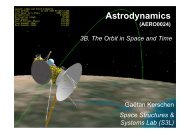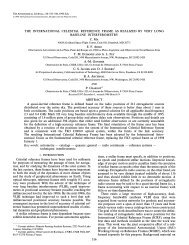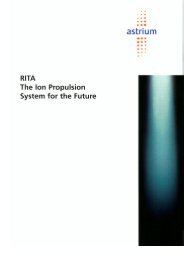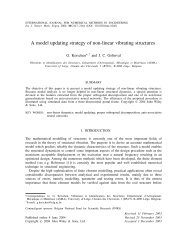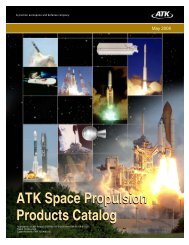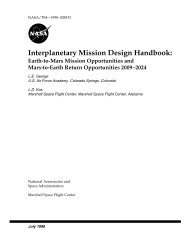CASSINI MANEUVER EXPERIENCE: FINISHING INNER CRUISE
CASSINI MANEUVER EXPERIENCE: FINISHING INNER CRUISE
CASSINI MANEUVER EXPERIENCE: FINISHING INNER CRUISE
Create successful ePaper yourself
Turn your PDF publications into a flip-book with our unique Google optimized e-Paper software.
in forecasting and planning the rest of the mission; in other<br />
words, updating Table I. With this is mind, the Navigation<br />
team has analyzed the execution errors to date.<br />
The maneuvers during early cruise [2], TCM-1 and<br />
TCM-2, are not included in this execution error analysis.<br />
TCM-2 is excluded because it was performed with the RCS,<br />
not the main engine. The first maneuver, TCM-1, was<br />
executed with a different accelerometer scale factor and an<br />
error in the algorithm for estimating maneuver magnitude.<br />
The focus of this analysis is on the maneuvers during<br />
inner cruise, that is, the maneuvers performed inside the<br />
asteroid belt. This includes the Deep Space Maneuver (DSM)<br />
and TCMs six through thirteen, and barring TCM-7, all of<br />
these employed the main engine.<br />
The spectacular maneuver performance discussed above<br />
has motivated the estimation of new Gates model parameters<br />
for maneuver execution error. With this new model in hand,<br />
more realistic AV estimates for the remainder of cruise and,<br />
more importantly, the tour may be made.<br />
In the above discussion of maneuver results, execution<br />
errors were discussed in the context of what was designed<br />
versus what was actually executed. However, those designs<br />
did not necessarily take advantage of all available models. For<br />
example, the design of TCM-6 did not account for the AV due<br />
to deadband-tightening. The design of TCM-9 did not account<br />
for the AV due to the pointing-bias-fix turn. These models<br />
are, however, a part of the best-available estimates used in the<br />
a posteriori analysis execution error analysis, below.<br />
The software set used for maneuver design does not<br />
model the AV due to the pointing-bias-fix turn, nor was the<br />
deadband-tightening AV included in every maneuver design.<br />
Therefore, the errors quoted in Table VI do not make use of<br />
the best available estimate for that maneuver. This analysis<br />
required that best available estimates be calculated for each<br />
maneuver. The best available estimate is made using current<br />
knowledge of the AVs associated with maneuvers. For<br />
example, it is only with experience that 3 m ds has become<br />
the best estimate for the deadband tightening AV. No pre-<br />
launch prediction of that AV was made.<br />
The DSM represents a special case because it is the only<br />
maneuver in the data set considered that was executed before<br />
the pointing bias fix. Therefore, the commanded burn AV<br />
must be rotated to coincide with the current best estimate of<br />
the main engine pointing direction.<br />
The magnitude errors are listed in Table VIII. The<br />
pointing errors are listed in Table X These errors are listed in<br />
units of speed, mds, as these are more natural units for<br />
estimating the Gates model parameters.<br />
10<br />
While the magnitude errors are one-dimensional and,<br />
given the small number of measurements, fairly easy to<br />
understand in a table, the pointing errors are two-dimensional<br />
and are best presented in a figure using angular units, viz.<br />
Figure 10.<br />
Table VIII: Best Estimate Magnitude Errors<br />
11.5615<br />
43.5504 -58.856<br />
5.1403<br />
I1 36.3182 -21.264 2.80<br />
12 12.2642 -10.669 3.44<br />
6 7185 8-04<br />
In perusing these data, several peculiarities are noticed.<br />
First and foremost, the DSM is the only overburn of the set<br />
and is still not understood. Also, if there were no mean fixed<br />
or proportional error, then one would expect half the samples<br />
to be underburns and half to be overburns. However, there<br />
does seem to be such a bias: a 0.1% underburn. If the DSM<br />
error were simply of the other sign, this would be a very<br />
comfortable conclusion. On the other hand, the DSM is<br />
unique enough (largest, pressure-regulated) to suspect it is<br />
truly an exception.<br />
-<br />
m<br />
.-<br />
.2<br />
Lo<br />
0.02,<br />
I<br />
0.01 -<br />
0"<br />
Q<br />
2 -0.01 -<br />
m<br />
Lo<br />
-0.02 -<br />
e<br />
-0.03 -<br />
. Lo<br />
-0.04 -<br />
L<br />
e<br />
-0.05 -<br />
v<br />
c 'E -0.06 -<br />
0,<br />
' -0.07 -<br />
TCM-6<br />
TCM-10 I<br />
TCM-13<br />
..~..~.....<br />
x<br />
TCM-11<br />
TCM-9<br />
-0.08 I<br />
0 5 10 15 20 25 30 35 40<br />
Maneuver Magnitude (m/s)<br />
Figure 8: Magnitude errors (I&) versus maneuver<br />
magnitude (ds).'<br />
~~<br />
* Overburns are positive, error bars indicate 1-0 uncertainties.<br />
DSM error is off scale (not shown).<br />
c<br />
4 5



